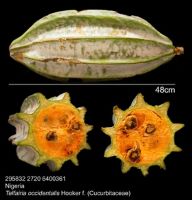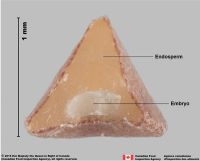Content is from Kirkbride et al. 2006Kirkbride et al. 2006:
Kirkbride JH, Jr, Gunn CR, and Dallwitz MJ. 2006. Family guide for fruits and seeds, vers. 1.0. Accessed September 2020-January 2022. URL: https://nt.ars-grin.gov/seedsfruits/keys/frsdfam/index.cfm ., without modification.
Updates are forthcoming.
Cones: Dry, or fleshyfleshy:
texture—fairly firm and dense, juicy or at least moist, and easily cut
(some Australian Ephredra); simplesimple:
fruit formed from a single flower with one pistil, solitary carpel or several fused carpels
when dry (Spjut recognized 3 families: Ephedraceae, Stangeriaceae, Zamiaceae); with sporophylls; with scalelike sporophylls; fleshyfleshy:
texture—fairly firm and dense, juicy or at least moist, and easily cut
simple cone for some spp. of Ephredra. Fruiting bracts present (& either membranousmembranous:
texture—extremely thin, pliable, and fairly tough
& winged, fleshyfleshy:
texture—fairly firm and dense, juicy or at least moist, and easily cut
, red); winged, or not winged.
Seeds: Arilaril:
(broad sense) appendicular structure that wholly or partly envelops a seed and is produced from or a modification of the funicle, raphe, or outer integument; usually fleshy or pulpy, sometimes spongy or tufted-capillate, often brightly colored absent. Seed larger than minute; ovateovate:
absent. Seed larger than minute; ovateovate:
2D shape—egg-shaped in outline, widest point is towards one end of the organ, the other end tapers gradually, attachment at or near the broad end (compare obovate, ovoid) , or circularcircular:
, or circularcircular:
(of embryo) linear embryo is curved into an "O" shape ; in transectiontransection:
; in transectiontransection:
a cross section; representing a plane made by cutting across an organ at a right angle to its length tereteterete:
tereteterete:
approximately circular in cross section; width and thickness approximately equal
 ; not bowl shaped; not nutlike; without winglike beakbeak:
; not bowl shaped; not nutlike; without winglike beakbeak:
a usually firm, terminal appendage, sometimes tapered ; without caudatecaudate:
; without caudatecaudate:
tapering to a long, tail-like appendage appendage(s); at maturity with food reserves; with endospermendosperm:
appendage(s); at maturity with food reserves; with endospermendosperm:
nutritive starch- and oil-containing tissue present in many seeds ; without canavanine. Sarcotestasarcotesta:
; without canavanine. Sarcotestasarcotesta:
pulpy or fleshy outer layer of the seed coat, simulates aril absent. Testatesta:
absent. Testatesta:
seed coat
 present; without markedly different marginalmarginal:
present; without markedly different marginalmarginal:
at, on, or close to the margin or border
tissue; with fleshyfleshy:
texture—fairly firm and dense, juicy or at least moist, and easily cut
or leatheryleathery:
texture—moderately thick, tough, and very pliable
layer over hard layer; without crease or line separating cotyledons from hypocotyl-radicle; without notch along margin where cotyledons from hypocotyl-radicle tip approach each other; without glands; without bristles; glabrousglabrous:
without hairs
; without wings; without collar; without operculumoperculum:
a dehiscent cap (or lid) of a seed or fruit that opens during germination or dehiscence
 ; colored; monochrome; brown (all shades), or yellow, or orange, or red; not becoming mucilaginousmucilaginous:
; colored; monochrome; brown (all shades), or yellow, or orange, or red; not becoming mucilaginousmucilaginous:
resembling mucilage; moist and sticky
when wetted; surrounding food reserve. Endospermendosperm:
nutritive starch- and oil-containing tissue present in many seeds without fatty acid containing cyclopropene; without apicalapical:
without fatty acid containing cyclopropene; without apicalapical:
at or pertaining to the end of the seed or fruit distal from its point of attachment (i.e., base)
lobes; without chlorophyll; without isodiametric faceted surface; without odor. Embryo differentiated from food reserve; well developed; 1 per seed; partially filling testatesta:
seed coat
 (with food reserve); 1 times the length of food reserve; at one end of seed not extending into a depression or cup; axileaxile:
(with food reserve); 1 times the length of food reserve; at one end of seed not extending into a depression or cup; axileaxile:
on or of the axis
and centric; foliatefoliate:
appearing leaf-like
; straight; parallel to seed length; with cotyledons gradually connected to hypocotyl-radicle; without coleorhiza; without simmondsin; without stomata; not green; with 2 or more cotyledons. Cotyledons 2; well developed; 0.6 times length of embryo; somewhat to significantly wider than hypocotyl-radicle; 1.25 times wider than hypocotyl-radicle; partially concealing hypocotyl-radicle; not foliaceous; flat; smooth; with apicesapex:
the point farthest from the point of attachment, or the "tip" of an organ entire; with margins separate; basally entire; equal in size; not punctatepunctate:
entire; with margins separate; basally entire; equal in size; not punctatepunctate:
surface relief—dotted with pits or with translucent, sunken glands or with colored dots, similar to pitted dotted. Hypocotyl-radicle moderately developed; straight; not thickened.
dotted. Hypocotyl-radicle moderately developed; straight; not thickened.
Seeds ripen with an outer envelope (from cone) becoming coriaceouscoriaceous:
texture—leathery
or fleshyfleshy:
texture—fairly firm and dense, juicy or at least moist, and easily cut
, sometimes vividly colored (yellow or orange). Bracts of stobilus 1) form membranousmembranous:
texture—extremely thin, pliable, and fairly tough
keeledkeel:
a longitudinal ridge, like the keel of a boat, formed by the lengthwise folding of a structure, such as a lemma or palea
 wings (wind disperal) and or 2) bracts becoming fleshyfleshy:
wings (wind disperal) and or 2) bracts becoming fleshyfleshy:
texture—fairly firm and dense, juicy or at least moist, and easily cut
and vividly colored & forming a 2-seeded pseudoberry (bird dispersal). Spjut's "simple simple:
fruit formed from a single flower with one pistil, solitary carpel or several fused carpels
cone" does not apply to this pseudoberry, because he defined a this cone as having "dry, woody-scalelike megasporophylls.
General references: Gunn, C.R., J.H. Wiersema, C.A. Ritchie, & J.H. Kirkbride, Jr. 1992 & amendments. Families and genera of Spermatophytes recognized by the Agricultural Research Service. Techn. Bull. U.S.D.A. 1796:1–500, Kubitzki, K. 1990. Gnetatae with the single living order Gnetales. In: Kubitzki, K., ed., The families and genera of vascular plants, vol. 1, pp. 378–391. Springer-Verlag, Berlin, Mabberley, D.J. 1987. The plant-book, 706 p. Cambridge University Press, Cambridge, and Spjut, R.W. 1994. A systematic treatment of fruit types. Mem. New York Bot. Gard. 70:1–182.